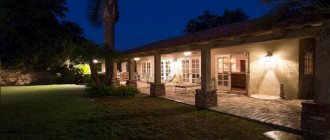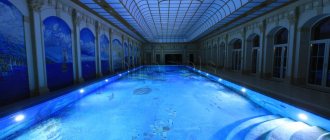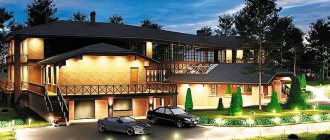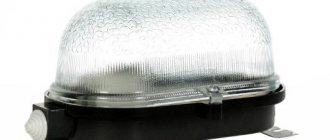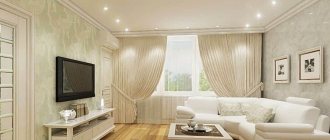Many factors in human life depend on light, the main one being comfort and coziness. The sun cannot illuminate the streets around the clock, so how can you feel safe? For this purpose, there is external lighting, thanks to which everyone can navigate the space. Also, do not forget about the beauty of the landscape, which is emphasized by a properly installed outdoor lighting system.
Outdoor lighting has several main types and many nuances. This should include not only technical, but also architectural solutions. Interior lighting helps us navigate indoors; this is also an important component of a comfortable life. This includes not only private houses and apartments, but also factories and industrial enterprises. Outdoor lighting is an important part of our lives and this material will tell you about it.
Types of Outdoor Lighting
Decorative lighting
This type of lighting is necessary to create special architectural solutions. Typically used in the design of parks, various city and public places, as well as private homes. This method illuminates buildings, bridges, squares, advertising stands and lampposts. If everything is done correctly, then a simple area can turn into a real fairy tale.
Outdoor LED lighting has a special place here. After all, LEDs are considered the most expensive and high-quality source. And this is true, such lamps can work for more than ten years, they do not produce a dull yellow flicker, but bright streams of white color. The placement of LEDs on the streets is one of the main tricks of decorative lighting. Unfortunately, such lamps are usually used in private enterprises and homes. The streets are illuminated with something simpler and cheaper.
The main trick to decorative lighting is the correct placement of light sources. You need to create a real plan, which will include the architectural features of the landscape or building. Harmony should be maximum, everything should be combined with adjacent light sources. For example, with a simple street lamp or floodlight, any discrepancy can spoil the overall picture.
Exterior architectural lighting also involves highlighting various landscaping elements when it comes to a park. Local, silhouette and flood lighting help make a real composition out of simple streams of light. External lighting is controlled using special units that are scattered throughout the city. The common man does not have access to these electronics; this is done for his safety.
Typically, streets and parks are illuminated using halogen lamps, sodium lamps and other varieties. Sometimes you can find LEDs, but in small quantities. The interior lighting of the park has a similar layout; it is always individual and depends on the surrounding area.
Lighting of local areas and private houses
In this case, interior lighting is used much more often; it is included in the layout of any building. Special attention is paid to the entrances of each residential building, because they must be constantly illuminated. Here it is necessary to clarify the fact that the lanterns should not produce too bright luminous fluxes. This will only disturb the residents of the house; they will not be able to sleep comfortably, because the light will always be shining through the windows.
Exterior lighting of a country house has its own distinctive features. If a private property has a driveway or garage, then these areas should be constantly illuminated. This is usually a spotlight that produces a very bright white light and operates remotely. In some cases, motion sensors are installed that respond to a suitable person or approaching car.
If the owner needs to constantly illuminate the path and porch next to his house, he uses an incandescent lamp or LED. There is a fluorescent lighting option, but it can only be used in warm climates. The fact is that such lamps do not work at sub-zero temperatures. Exterior home lighting doesn't end there, as we haven't mentioned design factors.
The facade and courtyard should be illuminated in such a way as to fit into the overall style of the building. For example, you can place several large lanterns near the porch, as well as several wall lights. This will provide a large amount of light and correctly emphasize the overall design style. It is advisable to install lamps and lanterns that can be adjusted at night. That is, giving a small amount of light at night will make the house very friendly and pleasant.
Don't forget about special bollard lamps that can be placed in the garden. They create a line of light that will look simply incredible. You can also use transparent Duralight cables, which can bring an incredible atmosphere to any home. There are also many other options for outdoor lighting of a private home, all of them must be selected individually depending on the preferences of the owner.
Lighting of urban areas - main milestones
External lighting of urban areas is one of the most important factors for the safety of residents. This also applies to architectural and design nuances that can be competently executed with the right approach. This type of outdoor lighting helps illuminate:
- streets for people;
- roads for cars;
- residential sectors;
- private facilities or industrial enterprises;
- business centers and retail outlets;
- educational institutions such as school or university.
External lighting is controlled by a dispatcher or turned on and off at certain times of the day.
Outdoor lighting in urban areas can be divided into several main types of outdoor lighting that comply with SNiP:
- Light that illuminates roads and highways. A reflective type of lighting is always used here; it helps to concentrate the flow of light to the desired point, for example, on a highway. This makes visibility maximum and movement comfortable. 250–400 W is the approximate power of such lanterns, which are always installed high enough to illuminate the surrounding area.
- Light for illuminating a secondary road; a reflector type or diffused lamp is used here. A special lampshade is always placed on the lantern; with its help, the light is scattered to the maximum distance.
- Light that illuminates buildings of architectural significance or facades.
- Light that illuminates pedestrian and bicycle areas, and recreational areas are also included in this category. Here they always use a diffused type of lighting, that is, a lantern with a special shade. Sometimes a special dump is installed, which evenly distributes the light and gives good visibility around the entire perimeter. Cylinder-shaped lampshades are the most popular; they have a standard relief structure and provide light well.
Lighting standards for underground and overground pedestrian crossings
| № | Illuminated objects | Esr, lx, no less |
| 1 | Underground pedestrian tunnels and passages: passages stairs and ramps | 75 40 |
| 2 | Open footbridges | 10 |
| 3 | Overhead pedestrian crossings with transparent walls and ceilings or glazed wall openings: passages staircases, ramps and viewing platforms | 75 50 |
Types of lanterns for outdoor lighting
The main criteria by which lanterns are selected:
- quality;
- aesthetics;
- lifetime.
They will ensure that urban areas are illuminated with the necessary light and residents are provided with safety. Most attention is paid to lamps that are installed in park areas and recreation areas. Here lamps perform all sorts of security, decorative and lighting functions. Lanterns can be classified by their type:
- gas lamp;
- variety with an incandescent lamp;
- oily based;
- with multiple arc lamps;
- LED lightening;
- induction lighting.
More recently, almost throughout Russia, only arc lamps with all their variations were used. As for small towns, mercury and sodium lamps are still popular there.
Annual cleaning and service factor
Operating factor (MF)
shows the ratio of the average illumination on a site of an object - in this case, a road, created by a lighting installation at the end of the established service life, to the average illumination on the same site, created at the beginning of operation. That is, if a lamp has a service life of 10 years, the service factor shows how much the illumination of the road from this lamp will decrease after these 10 years. Previously, a similar characteristic was used for calculations - the safety factor, which is the inverse of the operating factor (MF = 1 / KZ).
The operation coefficient takes into account the decrease in the lighting characteristics of lamps due to contamination and aging of the translucent parts of the structure, as well as due to the degradation of the light sources themselves and the failure of their individual parts (individual LEDs, for example). The following MF values are used for calculations:
- 0.7 - for sources based on metal halide lamps;
- 0.75 - for sources based on sodium lamps;
- 0.8 - for LED sources.
But these values are only valid if regular cleaning
lighting devices
at least twice a year
.
What criteria are used to choose outdoor lighting?
The responsibility of choosing lighting for urban areas should not be discussed. Everything must be thought out and executed with maximum precision. Each lamp or lantern must comply with the list of standards:
- Each lantern must provide good illumination of the surrounding areas, regardless of its placement. The lamp must comply with all standards and requirements.
- Each lighting device must provide additional safety on the road and in the pedestrian area. It has long been proven that due to poor lighting, accidents occur several times more often.
- All lanterns and lamps should look aesthetically pleasing and not “cut” the eyes of passers-by. They must perform architectural and design functions.
- Each lantern should have a long service life so that they do not have to be replaced every year. Durability is a very important criterion, because all lighting fixtures work for hours and are constantly subjected to incredible voltage and load. Therefore, the body of such flashlights must have maximum strength, reliability and resistance to damage. Lampshades usually have impact-resistant glass.
- Saving is probably the most important factor, especially in the CIS countries. The modern world has catastrophic energy problems, so you need to save on this parameter. A small city consumes an incredible amount of energy per day, so it is necessary to replace outdated streetlights with more economical options. The best option is LED lighting, which also has a long service life and reliability.
Principles of constructing street lighting
The lighting system is designed at the stage of laying new city streets - all parameters are taken into account, lighting devices are selected, the distance between pillars is calculated, etc. When making calculations, be sure to pay attention to the graininess of the road surface and the degree of light reflection, the level of dust on the road, the color of surrounding buildings and structures, road width and other factors. At the same time, the possibility of development and expansion of the microdistrict for at least 10 years is taken into account.
The layout of lamps and other devices can be different - single-row, double-row, single-sided and double-sided. Road lighting is done in two ways:
- lamps on a support;
- lanterns suspended on ropes.
In the first case, when the road width is less than 12 meters, the distance from the support to the next one can be about 35 meters. Typically, the location of lamps with such a street width is one-sided. If the width is 18 meters, a double-row checkerboard pattern is used. Wide routes (32 meters) are illuminated with rectangular checkerboard patterns.
If there is a dividing strip on the road between individual lanes of traffic, a two-lane scheme is used. The lamps stand on columns, each row illuminates its own strip. Lighting devices on cables are usually used for streets less than 18 meters wide, placing them on one side.
To illuminate pedestrian crossings, one device is installed on each side. Recreation areas and parks are recommended to be illuminated taking into account the overall architectural appearance of the city. The position of wires for public transport and the presence of other contact connections must be taken into account.
Where can I buy
You can purchase lamps as quickly as possible at your nearest specialty store. The optimal option, in terms of price-quality ratio, remains purchasing from the AliExpress online store. Mandatory long waits for parcels from China are a thing of the past, because now many goods are in intermediate warehouses in destination countries: for example, when ordering, you can select the “Delivery from the Russian Federation” option:
| Modern Outdoor Wall Lights, 10-13W | Stylish waterproof outdoor wall light, IP65 | LED street lamp |
| Street lamp with solar panel | Outdoor LED Waterproof Light | LED wall light, IP67 |
Beautiful architectural lighting or “light noise”?
Of course, decorative lighting of cities is a promising direction in modern architectural design. But every year there is more and more illumination in megacities, illuminated advertising banners are placed everywhere, bright store windows dazzle residents. Recently, the concepts of “light noise” and “light pollution” have become relevant - an excessive number of bright light structures in large cities. To ensure that the effect of illumination of urban space is not negative, it is necessary to avoid excessive illumination of residential buildings. Light rays should not be directly directed at the windows; the brightness of lighting fixtures should be strictly regulated. Modern LED lighting allows you to avoid the problem of “light noise” - the flow of rays can be concentrated in a certain plane, and the brightness of the lamps is also easily adjustable.
A well-designed concept for decorative city lighting will ensure comfort and safety on the streets, give pleasant impressions and a good mood to residents.
How to control outdoor lighting
External lighting control unit - it is with its help that the hourly supply of light is carried out. People call them very simply - control cabinets. They monitor and control all outdoor lighting in a specific area. They can remotely turn on and off lighting networks. With their help, the reception, accounting and general distribution of electrical energy is ensured. The outlet line is also protected from overload and short circuits.
The main function of such cabinets is to control all outdoor lighting, this applies to the evening and night. It is the blocks that illuminate cities, highways, roads, towns and dacha communities. Without their help, this process would be unmanageable and unable to operate.
What does the body of such a block look like?
Typically, the body of such a cabinet is made of a special series of polyester; it is made of thermoset plastic anti-vandal material. It practically cannot ignite, extinguishes itself (thanks to the pressed polyester), and has fiberglass reinforcement. All these materials together can provide the maximum level of strength and reliability of each block. They are resistant to any atmospheric influences and aggressive chemical environments. It is thanks to the material, its basic properties and special manufacturing technology that the cabinets cannot support combustion and are extremely fire resistant. They can perform the self-extinguishing process at temperatures of almost 1000 degrees Celsius. This does not exclude the fact that the city may often use simple thermoplastic blocks that do not have similar advantages.
The housing may have different levels of protection according to GOST R IEC 536-94, which means reinforced double insulation. A vandal-proof plastic cabinet made of polyester has a unique technical property: it is almost impossible to break or hack it. It is also worth mentioning the performance characteristics, which are as reliable and long-lasting as possible. The type of cabinet given as an example is not used everywhere, but is the best option for any street. Very often, such blocks are used in outdoor lighting of industrial enterprises or private areas.
Types of control cabinets
All cabinets are manufactured for outdoor installation and are therefore optimally suited for controlling outdoor lighting. Their cases have special and unique technical characteristics. They can help:
- Organize control of the light supply system for a highway or city road.
- Illuminate and control the general security system in a tunnel, road or railway.
- Manage the energy saving system, regulate and diagnose outdoor lighting. In this case, various automated units are often used.
- Light up streets using architectural and design nuances. The same goes for a park, any fountain, municipal building or cultural institution.
- They will help manage the video recording system, can signal a break-in, etc.
- Manage traffic or regulate traffic lights.
- Be involved in communication systems, that is, telecommunications, low-current equipment, the Internet.
Let us remind you that all control cabinets have different functionality. Some of them are used only to control the lighting of urban areas, others have more advanced technical characteristics and can be used in the above areas. It is also worth mentioning the way blocks are managed, it can be:
- local;
- manual;
- remote.
The last point is the presence of a control room, from where the employee controls the entire process.
Standards for lighting streets and roads in rural settlements
| № | Illuminated objects | Average horizontal illumination, lux |
| 1 | Main streets, squares, public and shopping centers | 10 |
| 2 | Residential streets: Basic Secondary (alleys) | 6 4 |
| 3 | Village roads, driveways on the territory of gardening partnerships and dacha cooperatives | 2 |
Outdoor lighting in country houses
A country house is a place of peace and comfort; this is where most people relax and improve their health. Here they spend weekends with family and friends; the festivities continue not only during the day, but also at night. This means that you need to take care of the outdoor lighting of your private home. Moreover, it must be carried out not just like that, but with full responsibility, because the site is the face of the owner.
How to take care of external lighting of the facade and adjacent paths
In order to properly illuminate the facade and paths, you need to draw up a whole plan. Every person loves to take care of the facade of their building, plant various bushes, trees and flowers. Sometimes ponds and small fountains are installed. During the day, all this beauty pleases guests and all visitors to your site, but at night it becomes invisible. The darkness does not cover them, but it also makes the house inhospitable. To get rid of this, you need to use outdoor lighting. The lanterns don't have to be very bright, you just need a small light source. Organizing this task may take you more than one day, but it is worth it. Lighting design is an essential part of any private home and owner who wants his home to look great.
Types of lighting for a private home
Types of lighting are distinguished by their functionality; it can be divided into four types:
- Technical type lighting. This is the case when you need to illuminate a door, main path, gate or gate. This variety has practically no decorative component; it serves as additional convenience and safety.
- Decorative lighting. This includes individual parts of the house itself, trees, bushes and other objects that are located on your property. This is the most important part of the entire plan, because the beauty of the entire site depends on it.
- Flood lighting type.
- Accompanying type of lighting. Several individual lamps that have motion sensors. They are typically used in the driveway or near the garage to avoid accidents.
Features of façade lighting
Your house is the main object on the entire site that needs to be illuminated. The light supply has different types and can be used individually. The main nuance in this system is to completely illuminate the facade and every corner of your home. You can also highlight small accents in places that should attract attention. This may apply to fountains, bushes or other architectural objects.
The façade can be divided into niches, statues, stucco moldings, columns, and family coats of arms. If you have similar interior items, then it is best to illuminate them with lanterns; sometimes you can use not standard lighting, but, for example, a bluish glow. To do this, you can use a simple color LED lamp, which is quite expensive, but has the maximum number of advantages.
One of the famous European designers advises every owner to use contour and hidden lighting for their home. The first type is distinguished by the fact that special cords and tubes are used, which have an LED base. They outline the overall appearance of the building, it looks simply incredible. An outline view will help anyone highlight all the necessary elements in their garden or near the facade. Columns, bay windows, roof elements, balustrades will take on a completely new look. The second type, that is, hidden lighting, is used to lightly illuminate all protruding parts. For example, a cornice, the bottom of a balcony, etc. LED tubes are used for this.
External lighting of a private house - tips
If the owner of a private house wants to make his territory truly perfectly lit, he must pay attention not only to the building. There are a hundred more individual elements to which a stream of light can be directed. Thanks to this approach, you can create a real composition that will make everyone look at your home with admiration. In other words, lighting the surrounding area is very important in the whole process.
If you are creating a decorative landscape lighting system, do not use fixtures that are visible. Such a light source will draw attention not to the desired space, but to itself. In addition, it will work in the opposite way - it will push attention away from the necessary parts and objects, darkening them due to the bright light. Hidden lighting devices are the best option.
When organizing external lighting of adjacent areas of the house, you need to divide the entire light supply system into several subsystems. For example, the main one illuminates the gate, the entire perimeter, the porch and several adjacent paths. The second is responsible for recreation areas, for example, a barbecue area, a gazebo. The third is no less important, it supplies light to the landscape.
Also, do not forget about the flood lighting system; flashlights are usually used for this. They can also be used to supply light to the entrance path to the house. When choosing a flashlight, you need to remember that there are millions of varieties of this lighting device. Your task is to study all the variations and choose the one that will be most in harmony with the overall design of the landscape and adjacent objects.
It is undesirable to use simple spotlights; they are too conservative and do not have any design flair. It is also worth thinking about original methods of lighting adjacent paths; there are many different methods. In most cases, LED tubes or alternating small lamps are used. Using the above methods, you can not only get light in a certain area, but also focus attention on certain objects.
An outline view will help anyone highlight all the necessary elements in their garden or near the facade. Columns, bay windows, roof elements, balustrades will take on a completely new look. The second type, that is, hidden lighting, is used to lightly illuminate all protruding parts. For example, a cornice, the bottom of a balcony, etc. LED tubes are used for this.
Ready solutions
Lighting of class A1 roads Class A1 roads include the most heavily loaded highways. Therefore, the most stringent requirements are applied to their lighting solutions. For the solutions presented here, high-power luminaires with wide luminaires and a large suspension height are used. Lighting of class A2 roads Lighting solutions for class A2 roads are similar to those for A1 roads, but they use lower power luminaires and a larger distance between supports, which makes them less expensive. Lighting of class A3 roads This article contains 3 solutions for lighting class A3 roads - main roads and city streets used by all types of transport. The projects are based on Pandora LED, Focus and Ferex lamps. Road lighting class A4 Economical solutions for lighting four-lane roads with average energy consumption of 2 kW/h per year per square meter of roadway. Calculations were performed using Pandora LED, LEDeffect and Ferex lamps. Lighting of roads of class B1 Solutions for lighting of roads of class B1 using LEDeffect, LeaderLight and Ferex lamps. A good example of the fact that more does not always mean better. B2 class road lighting Three solutions for B2 class road lighting for a distance between lighting masts from 30 to 45 meters based on Pandora LED, Ferex and Focus lamps. Road lighting class B1 The least trafficked four-lane roads among our solutions. Low-power luminaires and large distances between lighting poles make such solutions cost-effective both during the construction phase and beyond. Class B2 road lighting Economical solutions for lighting small city streets based on Pandora LED, Ferex and Focus lamps with lighting poles placed on one side of the road. Class B3 road lighting Economical solutions for lighting small city streets with an estimated power of about 1 kilowatt per 1 kilometer of road surface. Based on LEDeffect, LeaderLight, Ferex lamps.
Alternatives to manual street lighting calculations
In order for the reality after installing lanterns or floodlights to correspond to expectations, it is necessary to take into account a lot of factors. The final result can be affected by the properties of the lamps, the angle of the supports, aiming and glare, placement options for lighting devices and much more. Software products help to take into account a large number of factors and minimize errors.
The most popular among designers:
· Dialux – is able to take into account even weather conditions, build 2-dimensional and 3-dimensional models, and create video visualizations.
· Light-in-Night Road is a powerful tool for online calculation of street lighting for various objects from local roads to multi-level road junctions, highways and overpasses.
· NanoCAD – allows you to make accurate calculations and create design documentation, has a fairly simple interface.
The listed services have both free and commercial versions, supplemented with databases of lamps, and open up wide visualization possibilities. Programs are also an excellent opportunity to check and analyze the correctness of the calculations made. In addition, their use is necessary when it comes to an individual project, for example, a holiday park with a unique layout and personal landscape design.
Another alternative to using formulas is a street lighting calculator. Just enter the necessary parameters, and in a couple of seconds you will get the desired result.
